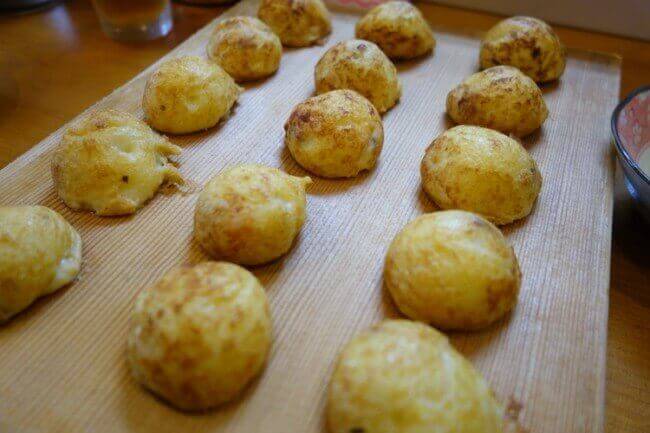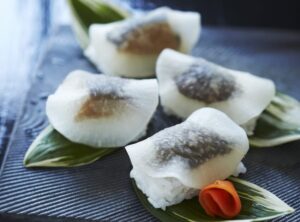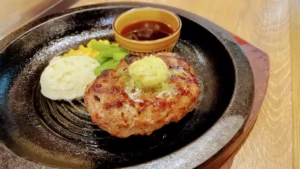Prepare to tantalize your taste buds with the mouthwatering allure of Akashiyaki, an irresistible delicacy hailing from the vibrant region of Hyougo in Kansai, Japan. Picture this: tender octopus pieces enveloped in a delectable batter, perfectly cooked to achieve a crispy exterior and a fluffy, flavorful interior. The result? A culinary masterpiece that has captivated both locals and visitors alike.
If you seek an unforgettable culinary adventure in Hyougo, Kansai, surrender to the allure of Akashiyaki. Let this irresistible specialty be your gateway to a world of flavors, where every bite is a moment of pure indulgence. Your taste buds are in for a treat that will linger in your memory long after the last piece is savored.
INTRODUCTION

Akashiyaki is a small round dumpling from the city of Akashi in Hyogo Prefecture, Japan. The dumpling is made of an egg-rich batter and octopus dipped into dashi. Locals refer to it simply as tamagoyaki or grilled egg. However, outside Akashi, it is called ‘Akashiyaki’.
It looks like a Takoyaki but actually, it’s different from Takoyaki. Although Takoyaki is a popular snack in Japan, it is actually based on Akashiyaki. Comparing to Takoyaki, Akashiyaki is a fluffy type and has a distinctly eggy taste. It doesn’t have any sauce or mayonnaise but in a clear dashi soup.
ETYMOLOGY

Akashiyaki in Japanese kanji is ‘明石焼き’. It is a regional cuisine of Akashi, a city in southern Hyogo prefecture. The name ‘Akashi’ is where the local cuisine originated. ‘Yaki’ is derived from ‘Yaku’ which is one of the cooking methods in Japanese cuisine. It means “to fry or grill”. These egg dumplings are commonly known as “tamagoyaki” in Akashi. However, outside of the area and nationally, they know it as “Akashiyaki”.
WHAT IS THE HISTORY OF AKASHIYAKI?

At the end of the Edo period, Akashi ball, or Akashitama is one of the important industries of Akashi. It is an imitation coral ornament that is made of egg whites as an adhesive. During that time, there was a craftsman named Edoya Iwakichi. It was inspired from the time he put an egg in his pocket on a cold day, then the egg broke and the egg white came out hard. It naturally leaves a lot of egg yolk and it’s a waste to throw them away. Therefore, it is one of the theories of how Akashiyaki started.
Akashiyaki is said to be the predecessor of Takoyaki. But it is actually the parent of Takoyaki which is called “rajioyaki”. It is a round snack made of flour, with konjac and beef fillings that was popular among kids around the 1920s. In the 1930s when a customer said in a food stall selling rajioyaki, telling that they use octopus in Akashi. Since then the Rajioyaki evolved and turned into Takoyaki. It was then quickly spread in Osaka and has become one of the area’s symbols ever since.
AKASHIYAKI VS TAKOYAKI

There’s actually a major difference between Takoyaki and Akashiyaki. Takoyaki has an ingredient of flour like okonomiyaki. While Akashiyaki is an egg dish that is a composition of lots of eggs. Another thing is the dipping and toppings. Akashiyaki comes with a small bowl of broth on the side for dipping before you eat. It has taken a larger role in forming the image of Akashiyaki.

In contrast to takoyaki which contains octopus and Tenkasu, the only ingredient in Akashiyaki is an octopus. In addition, takoyaki has toppings of bonito flakes, green laver, mayonnaise, and special Takoyaki sauce which Akashiyaki doesn’t have. Learn more about Takoyaki here.
WHAT ARE THE MAIN INGREDIENTS OF AKASHIYAKI?

Basically, the ingredients of making Agashiyaki is simple. You will be needing eggs, cake flour, salt, octopus, Dashi soup, and green onions. For the equipment, instead of the iron cooker, it is better to use copper ones for Akashiyaki. This is because it has excellent thermal conductivity, so it can finish soft and fluffy. For dashi stock, just simply season the water. Then soak it in kelp with salt or bonito and leave it for 24 hours.
WHAT IS THE RECIPE OF AKASHIYAKI?

Firstly, prepare the main ingredient which is Octopus. Wash and boil it first to remove the smell and slime. Cut the octopus into bite-sized pieces or 1cm. Next is to cut the green onions into small pieces. This shall float in the soup.
Next is to sift the cake flour and mix it with a whipper to prevent the cake flour from becoming lumpy. Add soup stock and mix well. Add it little by little and mix.
Add the egg yolk liquid mix well. Let the dough rest in the refrigerator for about 30 minutes.
Set the takoyaki mold on the stove and lightly oil it. It is convenient to soak the kitchen paper with oil and apply it. When the mold is warm, reduce the heat to low and pour the dough into the holes. If you use an electric takoyaki machine, adjust it to 180-200 °C.
In order to make fluffy Akashiyaki, it is important to adjust the heat.
Add the octopus one by one before the poured dough is burnt. After adding the octopus, pour the dough over it. Pour in plenty after 10 mins of cooking at the mold.
When the surface is bulging and the edges are burnt, turn it over with a skewer.
When the surface turns bright yellow and burns, it is complete. Remove it from the mold cooker and transfer it to a tray or plate then serve! Don’t forget to sprinkle green onions in your favorite soup stock and soak Akashiyaki in it!
WHAT ARE THE RECOMMENDED RESTAURANTS?

Takoiso
This restaurant is one of the famous and it is located close to the fishing port and shopping district. The Akashiyaki here is large and fluffy. In addition, the soup stock has an ingredient of bonito and kelp. In addition, there is also a variation of octopus with eel.
Akashiyaki Funamachi
Funamachi is a 15-minute walk from Akashi Station. This is also a popular store where you can see a long line almost every day. The taste of the eggs is gentle and fluffy. The seasoning is a piece of kelp from Southern Hokkaido and Ako salt, which is a specialty of Hyogo prefecture. No preservatives are used and there are also powdered bonito and green laver on the table.
Honke Kimuraya
Honke Kimuraya is about a 5-minute walk from JR Akashi Station. It is a very famous restaurant among many Akashiyaki restaurants. This restaurant is open since 1918. The Akashiyaki here is famous for its fluffy dough and its crunchy octopus inside. The egg flavor and dashi stock go great together.
Izumo
Izumo is about an 8-minute walk from Akashi Station. It is a popular shop with a continuous line of people, just a short walk from the Uo no Tana shopping street. Additionally, the menu here is Akashiyaka only and drinks. The texture is quite soft, and when you put it on the dashi stock, it crumbles. The taste of dashi is also very elegant.
Akashiyaki Go
Akashiyaki Go is about a 6-minute walk from Akashi Station. The contents of Akashiyaki are abundant, such as “Akashi octopus”, “Konnyaku” which Hyogo citizens love. They use a starch called “floating flour” which’s why the texture is smooth. On their menu, they have “GO Special Akashiyaki Udon” where you can enjoy udon and Akashiyaki together. This is indeed a must-try!
FINAL THOUGHTS

In conclusion, locals of Akashi usually called this dish Tamagoyaki which means grilled egg. Outside Akashi, people call it Akashiyaki. During the old times, people eat it to help fight the cold during winter. There’s even a theory that they discover it due to craftsmen using egg whites as their adhesives for their coral imitation ornaments such as hairpins. It would such a waste to just throw the egg yolk away. So practically, they were able to use it and that is how they invent Akashiyaki.
Moreover, Akashiyaki is older than Takoyaki. However, people seem to know more about Takoyaki and have less familiarity when it comes to Akashiyaki. Akashiyaki has a low count of calories and actually has enough protein. For every 10 pieces, the calorie count is about 337kcal. However, you can still gain fats if you think 10 pieces is not enough and just by thinking that you want to eat more. You can’t actually feel hungry even after eating Akashiyaki so people end up eating more. In addition, eating Akashiyaki is quite good but we need to limit and eat moderately as well.
















Comments